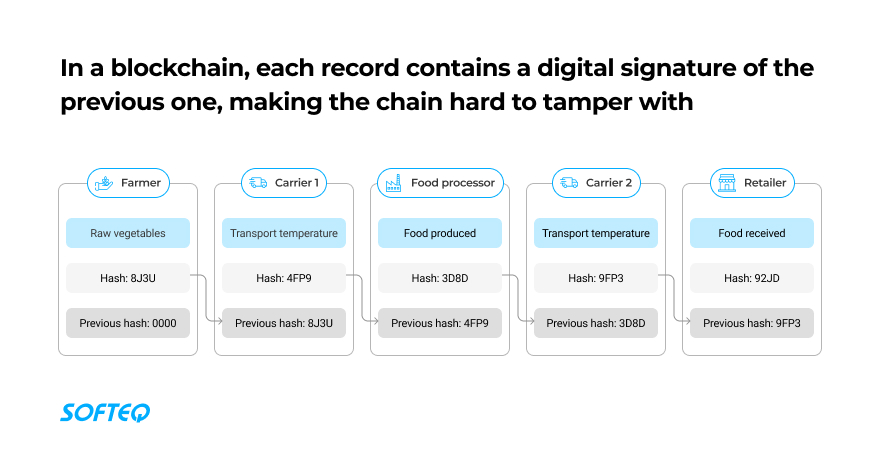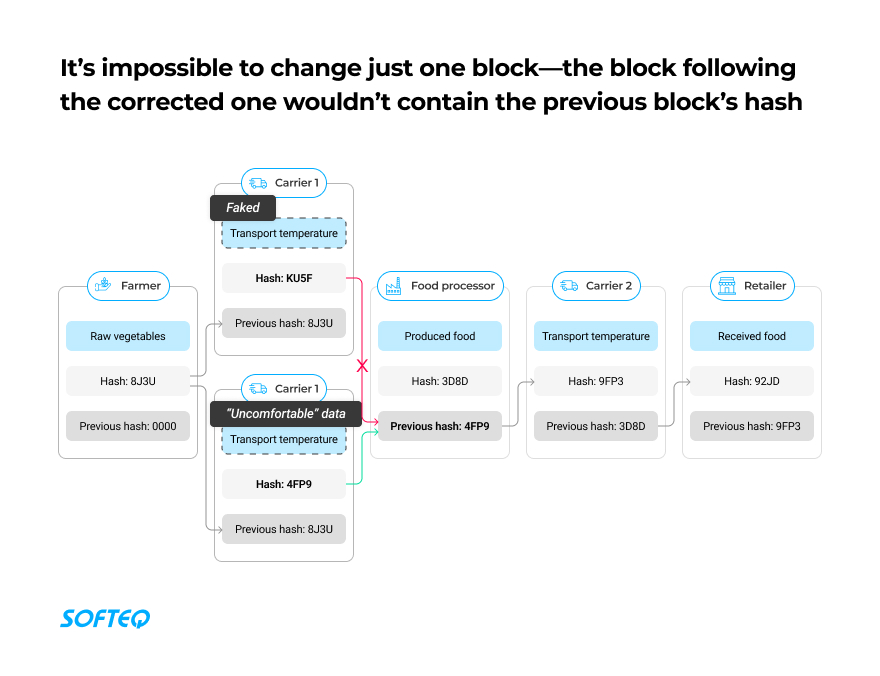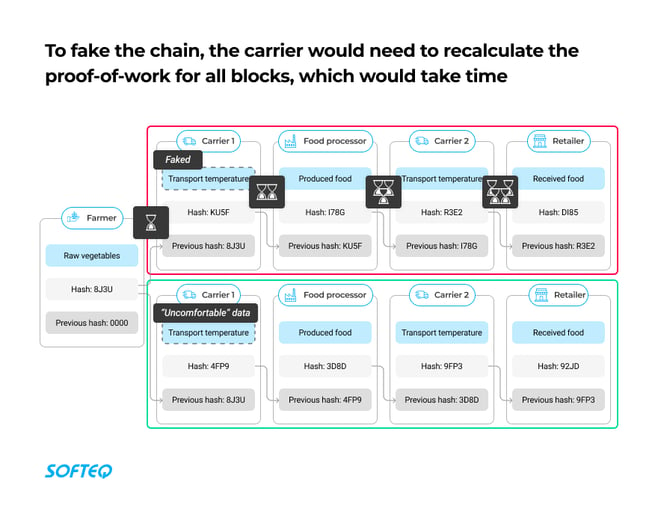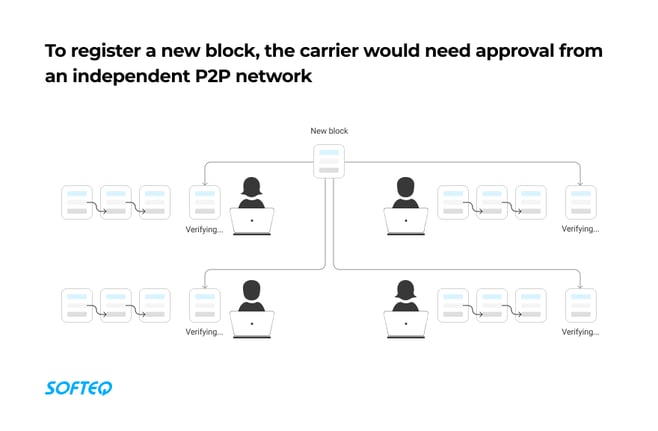Check out our latest blog article: From component to enterprise – modular robotics done right.
Blockchain for Business: Five Use Cases With Real-Life Examples

Why are middlemen an essential part of so many businesses? Because they help establish trust. Even the supply chains needed to produce the simplest products include multiple participating companies and transactions. And when those companies don’t know the person on the other side of the transaction, intermediaries verify important details. They verify that the seller has the right to sell and the buyer has the money to buy. They also confirm that the transaction history is clean. Of course, such benefits come at a cost. As such, middlemen make the transaction process more complicated, long, and expensive.
But what if there was a cheaper and more efficient intermediary? That’s exactly what blockchain could be for supply chains. This technology is fast, transparent, and error-free. In this article, we will talk about blockchain for business. Let’s get into how it works and look at real-world blockchain use cases by industry.
How Does Blockchain Work?
Blockchain is a technology that stores data in an encrypted form. It packs each data record into an individual block secured with a hash, a unique digital signature. Each block also contains the hash of the previous block, so they are linked together to form a chain. Once recorded, it becomes almost impossible to modify the data within the block and the block sequence itself. This makes a blockchain immutable.
For businesses, blockchain can be applied as a reliable source of truth. Companies can rely on the technology to verify the authenticity of documents, minimize transaction costs, and avoid supplier fraud. To see how it works, let’s take a look at an example.
Imagine a supermarket using blockchain to track the quality of products they buy. Their blockchain system records all the stages the product passes through from the farm to the store shelf. Each step in this process is recorded by the system as a separate block, which contains the following:
- Information about the transaction and goods like quantities, shipping conditions, and certification
- The hash, a unique digital signature for block identification
- The digital signature of the previous block

Let’s see what it gives us. One day, a carrier delivering raw vegetables to a processing plant had a problem. They didn’t meet the temperature specifications during transportation. With a traditional supply chain control system, the incident would probably have gone unnoticed. But the blockchain system records every event on the vegetables’ journey to the supermarket and alerts them of every violation. These records will be securely stored in the system as evidence. This means that, in case of claims from buyers, the responsibility will lie with the carrier.
Even if the carrier wanted to tamper with the record in the system, it would be impossible due to anti-tamper mechanisms. Let’s take a look at how they work:
1. Hashing. In a blockchain, each new event is always registered as a new block. This means that modifying the record is basically impossible. In this case, any attempt to correct something will be recorded as a new block with its own digital signature. Since each successive block contains the hash of the previous block, the carrier would have to tamper with the rest of the chain—quite a job.

2. Proof-of-work. But suppose the carrier has a powerful quantum computer that can calculate several thousand hashes per second. In this case, recalculating the entire hash chain is not a big deal. However, blockchain has a proof-of-work mechanism, an arbitrary mathematical puzzle that must be solved to create a new block. It slows down the creation of new blocks. So if the carrier decides to cheat, they’ll need to recalculate proof-of-work for all subsequent blocks. This will slow them down.

3. Peer-to-peer network. This is the final barrier to any cheating attempt. A peer-to-peer network includes millions of monitoring points. Each peer gets a complete copy of the blockchain. Their job is to verify each new block and approve its addition to the chain. If the peer finds any discrepancies, they will freeze the creation of the block. Consequently, to register a manipulated block, the carrier would need to control more than half of the peer-to-peer network. Practically impossible.

So, to successfully tamper with a blockchain, the carrier would have to do these three things:
- Tamper with all the blocks in the blockchain
- Redo the proof-of-work for each block
- Take control of more than half of the peer-to-peer network
These three methods make a blockchain a reliable source of truth. As a result, the technology can replace a trusted third party that would have been needed to verify data.
Now, let’s move on to blockchain use cases for businesses and their real-life examples.
Use Case 1: Blockchain in Retail. Verifying the Authenticity of Luxury Goods
Two out of five Americans are disappointed with their luxury shopping experience. Half have bought luxury items that turned out to be fake. The other half are not sure if they have bought authentic goods. As a result, brands lose customer loyalty and money.
In response, brands try to protect their intellectual property, which incurs further costs. For example, Moët Hennessy Louis Vuitton employs at least 60 lawyers. The corporation also spends $17 million annually on lawsuits against counterfeiting.
Blockchain can help identify fake items. Using blockchain, brands can create a digital twin for each luxury item, equip it with a token, and link it to the real product with a barcode. Using a smartphone, customers can scan the barcode to make sure the item is authentic.
Real-Life Example: Proving the Provenance of Diamonds
Global diamond mining firm De Beers uses blockchain to prove the provenance of every diamond they sell. The solution tracks a diamond’s journey, starting at the source and through the entire value chain. De Beers’ retailers use this solution to ensure the diamonds they buy are authentic. The system also helps them convince doubtful customers.
Benefits
- Preventing counterfeiting. Blockchain confirms the provenance of a luxury item by tracking the product through the entire value chain.
- Saving brands’ reputations. The technology proves the seller’s reliability by providing transparency.
- Improving customer experience. Blockchain eliminates the risk of running into fakes, making shopping more pleasurable.

Use Case 2: Blockchain in Healthcare. Expediting Credentialing
When a hospital tells a medical practitioner, “you’re hired”, it doesn’t mean they can get to work right away. First, a new physician needs to go through credentialing—a process through which hospitals ensure their new employees have the education, training, and certification they claim to have. It takes healthcare facilities time to authenticate the information. Typically, it takes 90 to 120 days of emailing and making calls. This means potential losses for the hospital while the physician sits idle. Administrative delays can cause a healthcare facility to lose $7,000 to $10,000 in potential revenue daily.
This is how blockchain could expedite the credentialing process: First, a doctor uploads documents to a blockchain system. Then, the issuing institution accesses it and verifies the provided information—just once, not each time the job changes. Finally, a health facility checks the verified data and the hospital can finally welcome its new employee. All this can save months.
Real-life Example: Verifying Healthcare Credentials Faster
Carilion Clinic, Virginia, tested blockchain to verify the credentials of their new hires. The clinic used a blockchain solution in parallel with their typical process for 17 residents. As a result, they were able to verify primary source records in minutes. If they had used blockchain for all their hires, they would have saved $1.2 million in lost revenue.
Benefits
- Speeding up document verification. With blockchain, credentialing takes minutes instead of months.
- Saving lost revenue. The technology allows hospitals to hire medical practitioners faster.
- Increasing the satisfaction of new hires. They no longer have to sit idle for months due to administrative delays.
Use Case 3: Blockchain and Intellectual Property. Facilitating Patent Transactions
Every patent transaction—be it acquisition, licensing, or pledge—requires due diligence. This process verifies the patent scope and ownership rights. If an owner has bought a patent, due diligence can reveal whether the transaction violated third-party rights. As a rule, this process requires a lot of time and money.
Blockchain can simplify due diligence and speed it up. The technology can be used to create registries for intellectual property (IP). They record every event in the life of an IP and make it available to the parties as evidence. For example, IP registries may contain information about when a trademark was first registered, applied for, and used in trade.
Real-Life Example: Simplifying Patent Trade
IPwe created a blockchain-based marketplace for IP. It enables businesses to tokenize their patents and then trade them as NFTs. The solution also uses AI for quick patent analysis and generates summaries and reports based on the patent documentation.
In general, the marketplace simplifies patent transactions and makes them less expensive. As for buyers, the product helps them find the most promising options for purchase and avoid commercial risks. Sellers, in turn, can better understand how they stand out versus their competitors.
Benefits
- Increasing transparency. Blockchain provides evidence of every event in the life of a patent.
- Reducing transactional costs. The technology makes patent trading simpler and cheaper by eliminating due diligence.
Use Case 4: Blockchain in Real Estate. Finding Investors for Expensive Properties
Finding investors for expensive properties is rarely quick. The main reason is their price: quality properties may cost millions of dollars. The quickest way to raise the amount of money required is a private placement. This is a strategy where an owner sells shares to proven investors instead of offering them for sale on the open market. This enables building owners to avoid extensive regulatory and reporting requirements.
However, private placements are generally out of reach for many investors. First, the typical minimum amount is still high—$50–100k. Second, private placements almost always require a long-term commitment: investors have to tie up their capital for 5–10 years.
To make real estate investment more accessible to small-scale private investors, owners can tokenize their properties. To do this, they divide a property into virtual parts and determine how much each part should be worth. Investors then buy the tokens and become co-owners of the sold property. This allows the owners to expand the pool of investors and sell buildings faster. Blockchain can also eliminate the need for a lawyer, banks, and even brokerage commissions.
Real-life Example: Selling a Luxury Building Faster
The Villa AnnA is a luxury building in Paris valued at €6.5 million. In order to sell the building faster, its owners decided to divide the building into 100 shares and distribute them between the owners. Each share will be further broken down into 100,000 tokens and sold for €6.5 each.
The tokens will comply with the French Monetary and Financial Code. Each token will entitle the holder to dividends, participation rights, voting rights at general meetings, and access to financial reports.
The owners will also use blockchain to record legal documents like notarized deeds and proof of identity. In this way, they want to save the cost and time needed to manually verify information about the investors.
Benefits
- Attracting investment faster. Blockchain can make investment accessible to small-scale investors too.
- Accelerating the transaction process. There’s no need to verify information about the investors manually.
Use Case 5: Blockchain in Transportation. Swapping Takeoff Slots
Flight delays cause extra costs for airlines. They have to pay compensation to passengers and sometimes change crew members. Costs can vary, depending on the flight destination and the severity of the delay. In order to reduce financial losses, airlines prioritize some flights and push back others. To do this, they need to find a suitable free runway takeoff slot. But the room for such maneuvers is limited: for security reasons, slots are usually exchanged only between flights of the same airline.
There’s also an option to arrange slot swapping between different airlines. In this case, they would have to disclose confidential information about flight costs to a trusted third party. Then, the intermediary would validate it and calculate the optimal slot for each airline. Airlines would have more options to optimize costs as a result. The trouble is that airlines don’t want to share their trade secrets with competitors.
Blockchain can make slot exchanges confidential using multi-party computation (MPC). This method encrypts data, performs calculations privately, and doesn’t reveal any details on the input data. As a result, airlines can take part in slot exchanges without risks.
Real-Life Example: Enabling Slot Exchange Between Different Airlines
SlotMachine is the first blockchain-based marketplace for airlines to exchange runway takeoff slots. The solution uses multi-party computation, which enables a greater degree of privacy over data. As a result, no airline accesses other companies’ data and sees what competitors are bidding on and how many slots different airlines have released.
The platform is still a work in progress. Once ready, it’s expected to reduce delays and increase airport efficiency.
Benefits
- Reducing airlines’ losses. With more slots available, airlines will have more flexibility to prioritize flights.
- Ensuring the confidentiality of trade secrets. Airlines don’t need to worry that information will fall into the hands of competitors.
- Increasing airport efficiency. Airport resources will be used more efficiently, reducing delays.
To Sum Up
Blockchain became famous because of speculation on cryptocurrencies. But even so, it can provide real value to businesses because of its incorruptible nature. Blockchain acts as a trusted intermediary, but it’s more efficient and cheaper. Companies use it to speed up due diligence and find investors faster. The technology also ensures the fairness of a deal while safeguarding trade secrets. In all these cases, businesses can make their operations more efficient and reduce costs.
If you want to take advantage of blockchain for business, contact us. We’ll help you build an entire blockchain infrastructure or any of its separate elements—blockchain core, nodes, or ecosystem apps.
More articles on the topic






